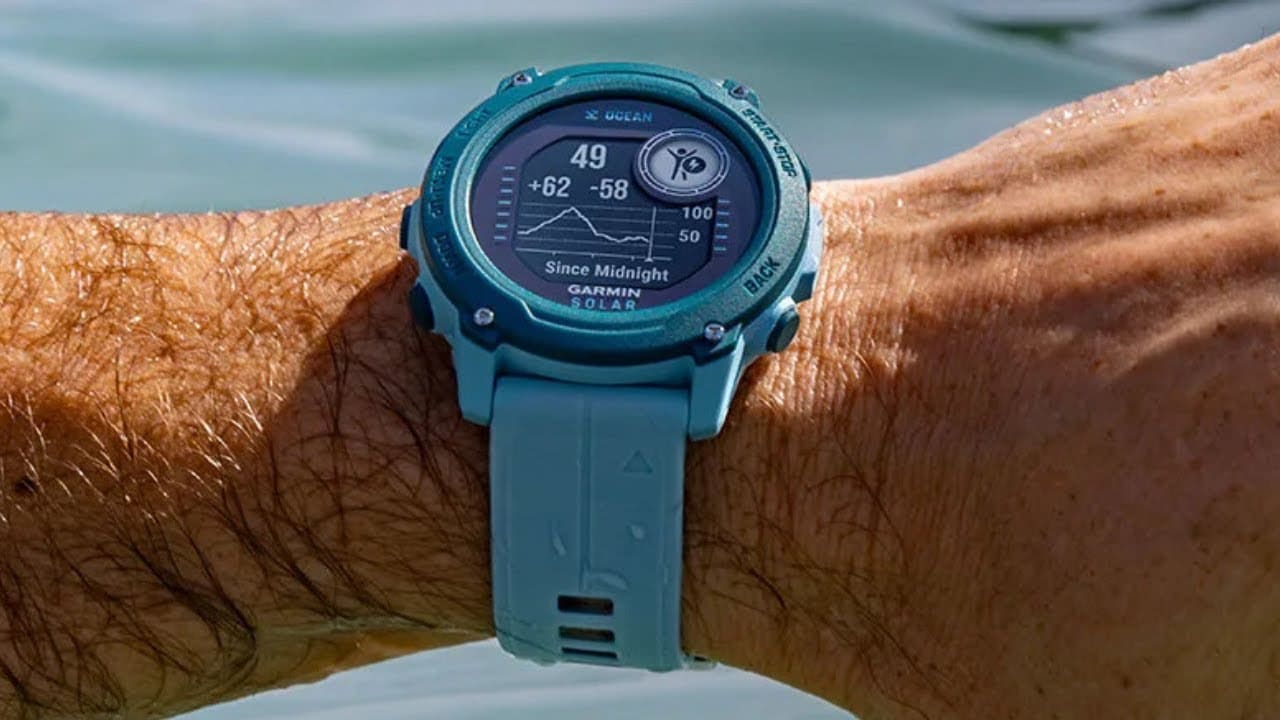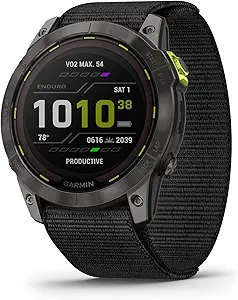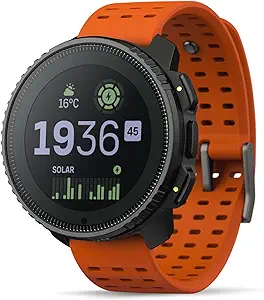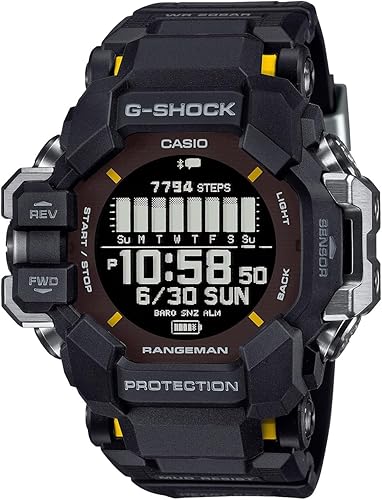Last Updated on October 9, 2025 by Luis Cooper
If you spend time outdoors, a solar-assisted watch can feel like a cheat code: fewer charges, longer trips, and less battery anxiety.
But not all “solar” systems work the same, and real-world gains vary a lot by panel area, screen tech, GPS use, and—most importantly—how much bright light you actually get.
This guide breaks down how solar charging really works in 2025, what you should expect day to day, and which models deliver reliable gains you can count on.
Top Solar Charging Smartwatches 2025:
How solar charging works: (and what’s realistic)
Modern solar watches hide transparent photovoltaic layers in or around the lens.
In bright sun they add energy back into the battery; indoors they contribute very little.
Expect meaningful gains only with consistent outdoor exposure.
Brands publish “with solar” numbers based on controlled light assumptions (e.g., ~3 hours/day at ~50,000 lux), so treat them as best-case guidance, not guarantees.
Garmin’s manuals explicitly tie “unlimited” claims to those high-brightness conditions, which most office or winter days won’t meet.
Screen tech matters:
Memory-in-pixel (MIP) displays sip power and benefit the most from solar; bright AMOLED or MicroLED screens cost more energy and rely less on solar to hit headline brightness.
If you want true “charge far less often,” pick MIP + large panel area + efficient GPS over sheer display punch.
How we evaluate real performance:
Solar Headroom:
Size and placement of the panel (ring vs full lens), plus the brand’s stated lux assumptions.
Battery math you feel:
Does solar offset typical daily drain (24/7 HR, notifications, a few GPS workouts), not just idle watch mode?
GPS efficiency:
Dual-band accuracy is great, but prolonged multiband can erase solar gains—power-miser modes matter.
Outdoor realism:
Consistency across seasons (short winter sun, cloud cover), not just desert-hike scenarios.
Rugged extras:
Mapping, emergency tools, and durability, because solar buyers are usually going long.
Best picks at a glance (2025)
Best overall solar adventure watch: Garmin fēnix 8 (Solar variants) — top maps, training tools, and new display options; solar still helps on longer trips.
Best battery-for-the-weight: Garmin Enduro 2 — monster GPS stamina with solar and an ultra-efficient platform.
Best rugged value solar: Garmin Instinct 2/2X Solar — durable MIP, “unlimited” smartwatch life under bright-sun assumptions.
Best mapping + solar outside Garmin: Suunto Vertical Solar — long daily runtime and +30% solar gain claims in bright conditions.
Best bomb-proof solar assist: Casio G-Shock Rangeman GPR-H1000 — timekeeping via solar; GPS and smart features still need USB.
Deep dives: What each watch really delivers
1. Garmin fēnix 8 (Solar variants) — the do-everything pick
Garmin’s fēnix 8 family adds brighter displays (including a flagship MicroLED on the 51 mm model) while keeping rugged build, full mapping, safety features, and solar on select “Sapphire Solar” editions.
The MicroLED/AMOLED options are easier to read in the sun; solar helps offset that extra brightness draw on longer trips.
For multi-sport athletes who live in topo maps and training metrics, it’s the most rounded choice in 2025.
Why it stands out:
Full-fat maps, dual-band GNSS, coaching/analytics, and new connectivity (LTE/inReach on certain models) make it a true expedition computer.
If you pick a Solar lens variant with MIP (where available), you’ll stretch the time between charges substantially.
Keep in mind:
The brightest displays draw more power than classic MIP fēnix models; solar offsets, it doesn’t perform miracles.
Check the specific “with solar” figures for your size/model.
2. Garmin Enduro 2: (Pure stamina for ultra days)
Think of Enduro 2 as Garmin’s range-extender: lightweight feel for its size, MIP display, power-saving GPS modes, and a solar lens tuned for multi-day efforts.
Garmin rates up to 150 hours in GPS with solar and up to 46 days in smartwatch with solar; reviewers consistently find it one of the longest-lasting watches you can buy.
If your priority is “go far, charge rarely,” this is still the reference.
Keep in mind:
You give up the fancier screen tech; this pick is about endurance first.
3. Garmin Instinct 2/2X Solar: (Rugged and affordable with real solar gains)
The Instinct 2 Solar series (and larger 2X Solar with a handy LED flashlight) offers the most accessible path to “charge less.”
With MIP displays and efficient software, Garmin even documents “unlimited” smartwatch life in bright-sun conditions (roughly 3 hours/day at ~50,000 lux).
Owners regularly report multi-week runtimes in mixed use.
The 2X’s larger panel improves energy capture and adds safety lighting.
Keep in mind:
“Unlimited” depends on a lot of outdoor sun; heavy GPS weeks still need the charger.
4. Suunto Vertical Solar: (Long daily life with excellent GPS)
Suunto’s Vertical Solar leans into efficiency: Suunto claims up to 60 days of daily use (and “up to one year” in time-mode-style scenarios) plus +30% battery from solar on the titanium solar variants.
Dual-frequency GPS is accurate in tough terrain, and the watch feels purpose-built for long mountain days.
If you want a less “smartwatchy,” more expedition-centric tool, this is a strong non-Garmin option.
Keep in mind:
Notification and third-party app ecosystems are simpler than Garmin’s; it’s an outdoor instrument first.
5. Casio G-Shock Rangeman: (Solar for timekeeping)
Casio’s Rangeman GPR-H1000 is tough as nails and solar powers the time display, but GPS and HR features still need a USB for meaningful use.
If you want field-proof durability with basic smart extras and like the idea of “the time always works,” this nails the brief.
Just don’t expect solar to run workouts or navigation indefinitely.
Choosing the right solar watch (quick decision guide)
Longest runtime between charges:
Choose MIP + big solar area (Garmin Enduro 2, Instinct 2/2X Solar).
Mapping + performance training:
Pick fēnix 8 Pro Solar with the display you prefer (MicroLED/AMOLED for visibility, MIP/Solar variants for endurance).
Non-Garmin, expedition vibe:
Suunto Vertical Solar for long daily battery and robust dual-band GPS.
Indestructible field tool:
G-Shock Rangeman GPR-H1000 if you want solar timekeeping with extreme durability and don’t mind USB for GPS/HR.
Real-world tips to maximize solar gains
1. Wear it outside, not under a cuff. Panel exposure is everything; even short dog walks and commutes add up. Garmin’s “unlimited” caveat assumes sustained bright sun (~50,000 lux).
2. Use power-miser GPS. For long hikes, switch from dual-band to single-band or “UltraTrac/Max Battery” equivalents; you’ll gain hours or days.
3. Mind bright screens. High-nits AMOLED/MicroLED erase solar headroom quickly during always-on, so use gestures or reduced timeout on sunny days.
4. Charge strategically. Top up before multi-day storms; solar helps, but it won’t rescue heavy GPS weeks indoors.
Specs:
Panel approach:
Full Power Sapphire/Power Glass lens (Garmin) vs solar ring/coating (Suunto). Full-lens designs tend to harvest more.
Battery claims with solar:
Enduro 2: up to 46 days smartwatch; up to 150 hours GPS.
Instinct 2/2X Solar:
“Unlimited” smartwatch life under ~3 h/day at ~50k lux; very long GPS in Max Battery.
Suunto Vertical Solar:
Up to 60 days daily use; up to +30% with solar; 85 hours at best GPS accuracy (solar/titanium).
fēnix 8 Solar variants:
Improved displays/connectivity; solar availability depends on version/size—check the exact model’s sheet.
G-Shock GPR-H1000:
Solar timekeeping, USB for GPS/HR; Casio details indoor/outdoor light assumptions.
FAQs:
Can any solar watch truly run forever?
Only in specific, very bright conditions and usually in low-drain watch modes.
Garmin documents “unlimited” for Instinct 2/2X smartwatch mode with ~3 h/day at ~50,000 lux; normal mixed use still benefits, but don’t skip the charger on cloudy weeks.
Does solar help during GPS workouts?
Yes, but less than you think.
GPS is the big energy draw; solar slows the drop but won’t cancel it unless you’re in strong, sustained sun with efficient GPS modes enabled.
Which brand leads solar in 2025?
For breadth and documentation, Garmin leads (Enduro/fēnix/Instinct). Suunto’s Vertical Solar is the strongest non-Garmin endurance option.
Casio excels in solar timekeeping on ultra-rugged platforms.
Will indoor light help?
A little, but it’s minor.
Casio quantifies that fluorescent light plus small weekly sun exposure can sustain timekeeping, not GPS/HR features.
Conclusion:
If your priority is days and weeks away from outlets, pick a MIP-based solar Garmin (Enduro 2 for maximum range; Instinct 2/2X Solar for rugged value). If you want a highly capable non-Garmin endurance watch, Suunto Vertical Solar offers long battery life and excellent GPS. If you need an indestructible field watch with solar timekeeping, Casio’s Rangeman GPR-H1000 is your no-nonsense pick. Choose the screen you’ll actually enjoy outdoors, then use power-miser GPS and give the panel real sun—that’s how you turn “solar” from a spec into fewer charges.
Related Articles:






